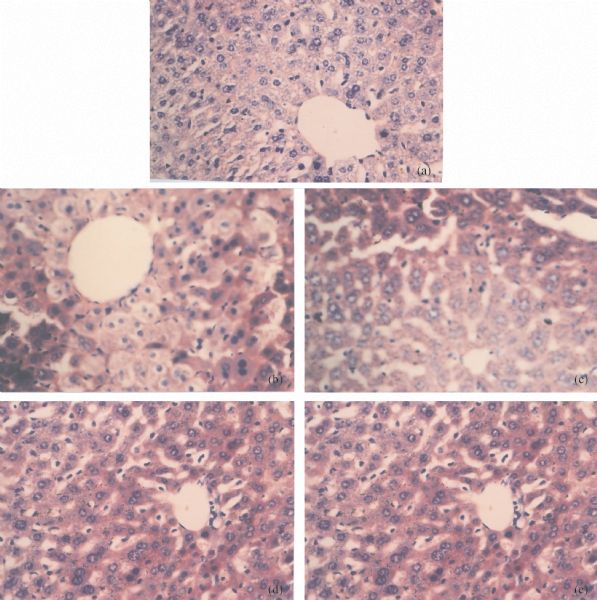

Experimental study on the efficacy of Fuganling granula on protecting against immunological hepatic injury
Received date: 11 Nov 2008
Accepted date: 26 Nov 2008
Published date: 05 Mar 2009
Copyright
To study the efficacy of Fuganling granula (FGL, 复肝灵颗粒) in treating mouse immunological hepatic injury that was caused by Bacille Calmette Guerin (BCG) and lipopolysaccharide (LPS), a total of 60 mice were adopted, among which, 50 mice were given intraperitoneal injection with BCG and LPS to establish an immunological liver injury model and then were randomly divided into 5 groups (10 mice/group): 4 groups received treatment of FGL orally at the doses of 100 mg/kg (high-dosage), 50 mg/kg (middle-dosage), 25 mg/kg (low-dosage) and bifendate orally at the dose of 80 mg/kg, respectively. One group was treated with distilled water orally. The remaining 10 mice were given distilled water intraperitoneally as the normal control group. The indices of thymus, liver and spleen, and the activities of the alanine aminotransferase (ALT), aspartate aminotransferase (AST) in the serum were detected. Compared to the normal rat, the model group’s thymus index decreased significantly. The liver index and spleen index increased significantly. The activities of serum ALT and AST increased significantly (all P< 0.01). Compared to the model control group, the group treated with FGL in high-dosage, middle-dosage or low-dosage can decrease the activities of ALT and AST and the group treated with FGL in high-dosage and middle-dosage can increase the thymus index significantly (P< 0.01). This experiment established the immunological liver injury model successfully and found that FGL has a remarkably protective effect on this kind of immunological hepatic injury.

Yanli LIU , Rong LIU , Cheng ZHEN , Quanfang GUO , Liping WU , Zhaoxi DING , Yushun BI , Zhiyu LIU . Experimental study on the efficacy of Fuganling granula on protecting against immunological hepatic injury[J]. Frontiers of Medicine, 2009 , 3(1) : 91 -95 . DOI: 10.1007/s11684-009-0011-z
| 1 |
GongN M, WeiL W, SunP, BiY S, LiuZ Y. Experiment study on the effect of Fuganling on liver injury induced by CCl4 in rabbit. Shandong Daxue Xuebao Yixuebao, 2006, 44(5): 460-462 (in Chinese)
|
| 2 |
XuS Y, BianR L, ChenX. Pharmacological Empirical Method. Beijing: People’s Medical Publishing House, 2002, 1346-1347 (in Chinese)
|
| 3 |
LiuP, SongD J. Etiopathogenesis of hepatic injury caused by drug. Ganzang, 2001, 6(1): 40-41 (in Chinese)
|
| 4 |
AndradeR J, LucenaM I, SantallaF. Hepatic injury associated with losartan. Ann Pharmacother, 1998, 32(12): 1371
|
| 5 |
LaiV, SmithA, ThorburnD, RamanV S. Severe hepatic injury and adulterated Chinese medicines. BMJ, 2006, 332(7536): 304-305
|
| 6 |
FinottoS, SieblerJ, HausdingM, SchippM, WirtzS, KleinS, ProtschkaM, DoganciA, LehrH A, TrautweinC, Khosravi-FahrR, StrandD, LohseA, GalleP R, BlessingM, NeurathM F. Severe hepatic injury in interleukin 18 (IL-18) transgenic mice: a key role for IL-18 in regulating hepatocyte apoptosis in vivo. Gut, 2004, 53(3): 392-400
|
| 7 |
MaX, GuL, ZhaoJ R, LeiD L, LangS H, YeL X, DongL Z, YuY P. Reparation function of hepatic cell growth substance in experimental hepatic injury. Weishengwuxue Mianyixue Jinzhan, 2000, 28(1): 37-40 (in Chinese)
|
| 8 |
WangH, WeiW, YueL, WangN P, GuiS Y, WuL, SunW Y, XuS Y. Protective effect of total glucosides of paeony on immunological liver injury in mice induced by Bacillus Calmette-Guerin plus lipopolysaccharide. Zhongguo Yaolixue Tongbao, 2004, 20(8): 875-878 (in Chinese)
|
| 9 |
XuH B, GongY P, ChengJ, ChuY W, XiongS D. CXCL16 participates in pathogenesis of immunological liver injury by regulating T lymphocyte infiltration in liver tissue. World J Gastroenterol, 2005, 11(32): 4979-4985
|
| 10 |
JuC. Immunological mechanisms of drug-induced liver injury. Curr Opin Drug Discov Devel, 2005, 8(1): 38-43
|
| 11 |
LiuD F, WeiW, SongL H. Protective effect of paeoniflorin on immunological liver injury induced by bacillus Calmette-Guerin plus lipopolysaccharide: modulation of tumour necrosis factor-alpha and interleukin-6 MRNA. Clin Exp Pharmacol Physiol, 2006, 33(4): 332-339
|
| 12 |
LiX. Curative effect and appreciation of glycyrrhizic acids drug in treating chronic virus hepatitis. Zhongguo Yaolixue Tongbao, 1999, 15(4): 383-384 (in Chinese)
|
| 13 |
WuJ C, WangZ R, WanQ H. The research of acute immunized hepat onecrosis animal model treated with the traditional Chinese medicine and anti-IL8. Suzhou Daxue XuebaoYixuebao, 2007, 27(2): 203 (in Chinese)
|
| 14 |
WuJ, LiL, ZouY. Determination of carbamate insecticides in Chinese medicinal herbs by gas chromatography with a nitrogen-phosphorus detector. J AOAC Int, 2005, 88(4): 1261-1264
|
| 15 |
ZhuP T, BoP, ChenX Y, WuY J, ChenC B, LiX M. Use W303-1A/hER-ERE-Lac Z to determine estrogenic compounds in traditional Chinese materia medica. Zhongguo Zhongyao Zazhi, 2007, 32(24): 2636-2639 (in Chinese)
|
| 16 |
YanceD R Jr, SagarS M. Targeting angiogenesis with integrative cancer therapies. Integr Cancer Ther, 2006, 5(1): 9-29
|
| 17 |
YangD G, DengX, LiuZ Y. Clinical observation of the liver cirrhosis with abnormal alpha fetoprotein treated by zhengganfang. Zhongxiyi Jiehe, 2007, 5(6): 351 (in Chinese)
|
| 18 |
GantnerF, LeistM, LohseA W, GermannP G, TiegsG. Concanavalin A-induced T cell mediated hepatic injury in mice: the role of tumor necrosis factor. Hepatology, 1995, 21(1): 190
|
| 19 |
YaoH W, YueL. Effect and mechanisms of FR167653, a dual inhibitor of TNF-alpha and IL-1, on BCG plus LPS induced-liver injury. Inflamm Res, 2005, 54(11): 471-477
|
| 20 |
XuH B, GongY P, JiangZ G, LiuR Z, XiongS D. The role of CXCL16 in immunological liver injury induced by BCG and LPS in mice. Zhonghua Ganzangbing Zazhi, 2005, 13(4): 282-285 (in Chinese)
|
/
| 〈 |
|
〉 |